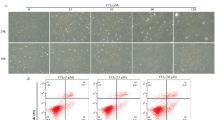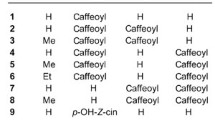Abstract
Tris (1, 3-dichloro-2-propyl) phosphate (TDCPP) is a major type of organophosphorus flame retardants, and long-term exposure to TDCPP to normal cells or tissues under physiological conditions can induce toxic effects. But how TDCPP leads to the adverse effects is not yet clear, and the effect of TDCPP under pathological conditions such as reactive oxygen species assault is not well understood. The present study aimed to explore the potential effect of TDCPP against H2O2-induced oxidative stress in H9c2 cardiomyoblasts and rat neonatal cardiomyocytes. We found that H2O2-treatment decreased cell viability and increased lactate dehydrogenase and malondialdehyde generation of H9c2 cells. However, TDCPP could alleviate these effects. TDCPP alleviated Ca2+-overload caused by H2O2 through decreasing store-operated calcium entry. More importantly, TDCPP remarkably decreased H2O2-induced dephosphorylation of Akt and GSK3β, and through this pathway TDCPP mitigated the H2O2-induced apoptosis and detrimental autophagy. Collectively, via mitigating Ca2+-overload and activating the Akt/GSK3β signaling pathway, TDCPP may have a role in protecting cardiomyocytes from oxidative stress.







Similar content being viewed by others
References
Jennings RB (2013) Historical perspective on the pathology of myocardial ischemia/reperfusion injury. Circ Res 113(4):428–438. https://doi.org/10.1161/circresaha.113.300987
MacLellan WR, Schneider MD (1997) Death by design. Programmed cell death in cardiovascular biology and disease. Circ Res 81(2):137–144
Saraste A, Pulkki K, Kallajoki M, Henriksen K, Parvinen M, Voipio-Pulkki LM (1997) Apoptosis in human acute myocardial infarction. Circulation 95(2):320–323
Morgan MJ, Liu ZG (2010) Reactive oxygen species in TNFalpha-induced signaling and cell death. Mol Cells 30(1):1–12. https://doi.org/10.1007/s10059-010-0105-0
Darley-Usmar VM, Stone D, Smith D, Martin JF (1991) Mitochondria, oxygen and reperfusion damage. Ann Med 23(5):583–588
Bernardi P, Di Lisa F (2015) The mitochondrial permeability transition pore: molecular nature and role as a target in cardioprotection. J Mol Cell Cardiol 78:100–106. https://doi.org/10.1016/j.yjmcc.2014.09.023
Brookes PS, Yoon Y, Robotham JL, Anders MW, Sheu SS (2004) Calcium, ATP, and ROS: a mitochondrial love-hate triangle. Am J Physiol Cell Physiol 287(4):C817–C833. https://doi.org/10.1152/ajpcell.00139.2004
Chou HC, Chen YW, Lee TR, Wu FS, Chan HT, Lyu PC, Timms JF, Chan HL (2010) Proteomics study of oxidative stress and Src kinase inhibition in H9C2 cardiomyocytes: a cell model of heart ischemia-reperfusion injury and treatment. Free Radic Biol Med 49(1):96–108. https://doi.org/10.1016/j.freeradbiomed.2010.04.001
Law CH, Li JM, Chou HC, Chen YH, Chan HL (2013) Hyaluronic acid-dependent protection in H9C2 cardiomyocytes: a cell model of heart ischemia-reperfusion injury and treatment. Toxicology 303:54–71. https://doi.org/10.1016/j.tox.2012.11.006
Chou HC, Chan HL (2014) 5-Methoxytryptophan-dependent protection of cardiomyocytes from heart ischemia reperfusion injury. Arch Biochem Biophys 543:15–22. https://doi.org/10.1016/j.abb.2013.12.014
Lemasters JJ, Qian T, He L, Kim JS, Elmore SP, Cascio WE, Brenner DA (2002) Role of mitochondrial inner membrane permeabilization in necrotic cell death, apoptosis, and autophagy. Antioxid Redox Signal 4(5):769–781. https://doi.org/10.1089/152308602760598918
Liu CY, Zhang YH, Li RB, Zhou LY, An T, Zhang RC, Zhai M, Huang Y, Yan KW, Dong YH, Ponnusamy M, Shan C, Xu S, Wang Q, Zhang YH, Zhang J, Wang K (2018) LncRNA CAIF inhibits autophagy and attenuates myocardial infarction by blocking p53-mediated myocardin transcription. Nat Commun 9(1):29. https://doi.org/10.1038/s41467-017-02280-y
Chao HR, Wang SL, Lee WJ, Wang YF, Papke O (2007) Levels of polybrominated diphenyl ethers (PBDEs) in breast milk from central Taiwan and their relation to infant birth outcome and maternal menstruation effects. Environ Int 33(2):239–245. https://doi.org/10.1016/j.envint.2006.09.013
Herbstman JB, Sjodin A, Kurzon M, Lederman SA, Jones RS, Rauh V, Needham LL, Tang D, Niedzwiecki M, Wang RY, Perera F (2010) Prenatal exposure to PBDEs and neurodevelopment. Environ Health Perspect 118(5):712–719. https://doi.org/10.1289/ehp.0901340
Main KM, Kiviranta H, Virtanen HE, Sundqvist E, Tuomisto JT, Tuomisto J, Vartiainen T, Skakkebaek NE, Toppari J (2007) Flame retardants in placenta and breast milk and cryptorchidism in newborn boys. Environ Health Perspect 115(10):1519–1526. https://doi.org/10.1289/ehp.9924
Meeker JD, Johnson PI, Camann D, Hauser R (2009) Polybrominated diphenyl ether (PBDE) concentrations in house dust are related to hormone levels in men. Sci Total Environ 407(10):3425–3429. https://doi.org/10.1016/j.scitotenv.2009.01.030
Nam W, Lee HJ, Oh SY, Kim C, Jang HG (2000) First success of catalytic epoxidation of olefins by an electron-rich iron(III) porphyrin complex and H2O2: imidazole effect on the activation of H2O2 by iron porphyrin complexes in aprotic solvent. J Inorg Biochem 80(3–4):219–225
Meeker JD, Stapleton HM (2010) House dust concentrations of organophosphate flame retardants in relation to hormone levels and semen quality parameters. Environ Health Perspect 118(3):318–323. https://doi.org/10.1289/ehp.0901332
Meijer M, Dingemans MM, van den Berg M, Westerink RH (2014) Inhibition of voltage-gated calcium channels as common mode of action for (mixtures of) distinct classes of insecticides. Toxicol Sci 141(1):103–111. https://doi.org/10.1093/toxsci/kfu110
Westerink RH (2014) Modulation of cell viability, oxidative stress, calcium homeostasis, and voltage- and ligand-gated ion channels as common mechanisms of action of (mixtures of) non-dioxin-like polychlorinated biphenyls and polybrominated diphenyl ethers. Environ Sci Pollut Res Int 21(10):6373–6383. https://doi.org/10.1007/s11356-013-1759-x
Dingemans MM, de Groot A, van Kleef RG, Bergman A, van den Berg M, Vijverberg HP, Westerink RH (2008) Hydroxylation increases the neurotoxic potential of BDE-47 to affect exocytosis and calcium homeostasis in PC12 cells. Environ Health Perspect 116(5):637–643. https://doi.org/10.1289/ehp.11059
Dingemans MM, Heusinkveld HJ, Bergman A, van den Berg M, Westerink RH (2010) Bromination pattern of hydroxylated metabolites of BDE-47 affects their potency to release calcium from intracellular stores in PC12 cells. Environ Health Perspect 118(4):519–525. https://doi.org/10.1289/ehp.0901339
Dingemans MM, van den Berg M, Bergman A, Westerink RH (2010) Calcium-related processes involved in the inhibition of depolarization-evoked calcium increase by hydroxylated PBDEs in PC12 cells. Toxicol Sci 114(2):302–309. https://doi.org/10.1093/toxsci/kfp310
He X, Li S, Fang X, Liao Y (2018) TDCPP protects cardiomyocytes from hypoxia-reoxygenation injury induced apoptosis through mitigating calcium overload and promotion GSK-3beta phosphorylation. Regul Toxicol Pharmacol 92:39–45. https://doi.org/10.1016/j.yrtph.2017.11.005
He X, Li S, Liu B, Susperreguy S, Formoso K, Yao J, Kang J, Shi A, Birnbaumer L, Liao Y (2017) Major contribution of the 3/6/7 class of TRPC channels to myocardial ischemia/reperfusion and cellular hypoxia/reoxygenation injuries. Proc Natl Acad Sci USA 114(23):E4582–E4591. https://doi.org/10.1073/pnas.1621384114
Maciel EN, Vercesi AE, Castilho RF (2001) Oxidative stress in Ca(2+)-induced membrane permeability transition in brain mitochondria. J Neurochem 79(6):1237–1245
Grynkiewicz G, Poenie M, Tsien RY (1985) A new generation of Ca2 + indicators with greatly improved fluorescence properties. J Biol Chem 260(6):3440–3450
Wagner S, Ruff HM, Weber SL, Bellmann S, Sowa T, Schulte T, Anderson ME, Grandi E, Bers DM, Backs J, Belardinelli L, Maier LS (2011) Reactive oxygen species-activated Ca/calmodulin kinase IIdelta is required for late I(Na) augmentation leading to cellular Na and Ca overload. Circ Res 108(5):555–565. https://doi.org/10.1161/CIRCRESAHA.110.221911
Wagner S, Seidler T, Picht E, Maier LS, Kazanski V, Teucher N, Schillinger W, Pieske B, Isenberg G, Hasenfuss G, Kogler H (2003) Na(+)-Ca(2+) exchanger overexpression predisposes to reactive oxygen species-induced injury. Cardiovasc Res 60(2):404–412
Becker LB (2004) New concepts in reactive oxygen species and cardiovascular reperfusion physiology. Cardiovasc Res 61(3):461–470. https://doi.org/10.1016/j.cardiores.2003.10.025
Nakai A, Yamaguchi O, Takeda T, Higuchi Y, Hikoso S, Taniike M, Omiya S, Mizote I, Matsumura Y, Asahi M, Nishida K, Hori M, Mizushima N, Otsu K (2007) The role of autophagy in cardiomyocytes in the basal state and in response to hemodynamic stress. Nat Med 13(5):619–624. https://doi.org/10.1038/nm1574
Sebastiano Sciarretta Y, Maejima D, Zablocki S aJ (2018) The role of autophagy in the heart. Annu Rev Physiol 80:1–26. https://doi.org/10.1146/annurev-physiol-021317121427
Dishaw LV, Powers CM, Ryde IT, Roberts SC, Seidler FJ, Slotkin TA, Stapleton HM (2011) Is the PentaBDE replacement, tris (1,3-dichloro-2-propyl) phosphate (TDCPP), a developmental neurotoxicant? Studies in PC12 cells. Toxicol Appl Pharmacol 256(3):281–289. https://doi.org/10.1016/j.taap.2011.01.005
Liu C, Wang Q, Liang K, Liu J, Zhou B, Zhang X, Liu H, Giesy JP, Yu H (2013) Effects of tris(1,3-dichloro-2-propyl) phosphate and triphenyl phosphate on receptor-associated mRNA expression in zebrafish embryos/larvae. Aquat Toxicol 128–129:147–157. https://doi.org/10.1016/j.aquatox.2012.12.010
Wang Q, Liang K, Liu J, Yang L, Guo Y, Liu C, Zhou B (2013) Exposure of zebrafish embryos/larvae to TDCPP alters concentrations of thyroid hormones and transcriptions of genes involved in the hypothalamic-pituitary-thyroid axis. Aquat Toxicol 126:207–213. https://doi.org/10.1016/j.aquatox.2012.11.009
Ta N, Li C, Fang Y, Liu H, Lin B, Jin H, Tian L, Zhang H, Zhang W, Xi Z (2014) Toxicity of TDCPP and TCEP on PC12 cell: changes in CAMKII, GAP43, tubulin and NF-H gene and protein levels. Toxicol Lett 227(3):164–171. https://doi.org/10.1016/j.toxlet.2014.03.023
Yellon DM, Hausenloy DJ (2007) Myocardial reperfusion injury. N Engl J Med 357(11):1121–1135. https://doi.org/10.1056/NEJMra071667
Dorn GW IInd (2009) Apoptotic and non-apoptotic programmed cardiomyocyte death in ventricular remodelling. Cardiovasc Res 81(3):465–473. https://doi.org/10.1093/cvr/cvn243
Murphy E, Steenbergen C (2008) Mechanisms underlying acute protection from cardiac ischemia-reperfusion injury. Physiol Rev 88(2):581–609. https://doi.org/10.1152/physrev.00024.2007
Takano H, Zou Y, Hasegawa H, Akazawa H, Nagai T, Komuro I (2003) Oxidative stress-induced signal transduction pathways in cardiac myocytes: involvement of ROS in heart diseases. Antioxid Redox Signal 5(6):789–794. https://doi.org/10.1089/152308603770380098
Li W, Wang YP, Gao L, Zhang PP, Zhou Q, Xu QF, Zhou ZW, Guo K, Chen RH, Yang HT, Li YG (2013) Resveratrol protects rabbit ventricular myocytes against oxidative stress-induced arrhythmogenic activity and Ca2+ overload. Acta Pharmacol Sin 34(9):1164–1173. https://doi.org/10.1038/aps.2013.82
Peng TI, Jou MJ (2010) Oxidative stress caused by mitochondrial calcium overload. Ann N Y Acad Sci 1201:183–188. https://doi.org/10.1111/j.1749-6632.2010.05634.x
Omar MA, Wang L, Clanachan AS (2010) Cardioprotection by GSK-3 inhibition: role of enhanced glycogen synthesis and attenuation of calcium overload. Cardiovasc Res 86(3):478–486. https://doi.org/10.1093/cvr/cvp421
Juhaszova M, Zorov DB, Yaniv Y, Nuss HB, Wang S, Sollott SJ (2009) Role of glycogen synthase kinase-3beta in cardioprotection. Circ Res 104(11):1240–1252. https://doi.org/10.1161/circresaha.109.197996
Miyake H, Nelson C, Rennie PS, Gleave ME (2000) Testosterone-repressed prostate message-2 is an antiapoptotic gene involved in progression to androgen independence in prostate cancer. Cancer Res 60(1):170–176
Miura T, Miki T (2009) GSK-3beta, a therapeutic target for cardiomyocyte protection. Circ J 73(7):1184–1192
Pchejetski D, Kunduzova O, Dayon A, Calise D, Seguelas MH, Leducq N, Seif I, Parini A, Cuvillier O (2007) Oxidative stress-dependent sphingosine kinase-1 inhibition mediates monoamine oxidase A-associated cardiac cell apoptosis. Circ Res 100(1):41–49. https://doi.org/10.1161/01.res.0000253900.66640.34
Shiroto K, Otani H, Yamamoto F, Huang CK, Maulik N, Das DK (2005) MK2−/− gene knockout mouse hearts carry anti-apoptotic signal and are resistant to ischemia reperfusion injury. J Mol Cell Cardiol 38(1):93–97. https://doi.org/10.1016/j.yjmcc.2004.10.018
De Windt LJ, Lim HW, Taigen T, Wencker D, Condorelli G, Dorn GW IInd, Kitsis RN, Molkentin JD (2000) Calcineurin-mediated hypertrophy protects cardiomyocytes from apoptosis in vitro and in vivo: an apoptosis-independent model of dilated heart failure. Circ Res 86(3):255–263
Gross ER, Hsu AK, Gross GJ (2004) Opioid-induced cardioprotection occurs via glycogen synthase kinase beta inhibition during reperfusion in intact rat hearts. Circ Res 94(7):960–966. https://doi.org/10.1161/01.res.0000122392.33172.09
Zhai P, Sciarretta S, Galeotti J, Volpe M, Sadoshima J (2011) Differential roles of GSK-3beta during myocardial ischemia and ischemia/reperfusion. Circ Res 109(5):502–511. https://doi.org/10.1161/CIRCRESAHA.111.249532
Acknowledgements
This research was supported by the National Natural Science Foundation of China Grants 30970662 (to Y.H.) and the Natural Science Foundation of Hubei Province of China 2018CFB668 (to X.J.).
Author information
Authors and Affiliations
Corresponding authors
Ethics declarations
Conflict of interest
The authors declare that they have no conflict of interest.
Rights and permissions
About this article
Cite this article
Zhang, W., Hou, X., Huang, M. et al. TDCPP protects cardiomyocytes from H2O2-induced injuries via activating PI3K/Akt/GSK3β signaling pathway. Mol Cell Biochem 453, 53–64 (2019). https://doi.org/10.1007/s11010-018-3431-8
Received:
Accepted:
Published:
Issue Date:
DOI: https://doi.org/10.1007/s11010-018-3431-8




